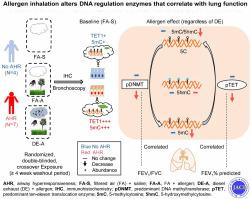Journal of Allergy and Clinical Immunology ( IF 14.2 ) Pub Date : 2020-10-15 , DOI: 10.1016/j.jaci.2020.08.044 Hang Li 1 , Min Hyung Ryu 2 , Christopher F Rider 2 , Wayne Tse 2 , Rachel L Clifford 3 , Maria J Aristizabal 4 , Weiping Wen 5 , Chris Carlsten 2

|
Background
Epidemiological data show that traffic-related air pollution contributes to the increasing prevalence and severity of asthma. DNA methylation (DNAm) changes may elucidate adverse health effects of environmental exposures.
Objectives
We sought to assess the effects of allergen and diesel exhaust (DE) exposures on global DNAm and its regulation enzymes in human airway epithelium.
Methods
A total of 11 participants, including 7 with and 4 without airway hyperresponsiveness, were recruited for a randomized, double-blind crossover study. Each participant had 3 exposures: filtered air + saline, filtered air + allergen, and DE + allergen. Forty-eight hours postexposure, endobronchial biopsies and bronchoalveolar lavages were collected. Levels of DNA methyltransferases (DNMTs) and ten-eleven translocation (TET) enzymes, 5-methylcytosine, and 5-hydroxymethylcytosine were determined by immunohistochemistry. Cytokines and chemokines in bronchoalveolar lavages were measured by electrochemiluminescence multiplex assays.
Results
Predominant DNMT (the most abundant among DNMT1, DNMT3A, and DNMT3B) and predominant TET (the most abundant among TET1, TET2, and TET3) were participant-dependent. 5-Methylcytosine and its regulation enzymes differed between participants with and without airway hyperresponsiveness at baseline (filtered air + saline) and in response to allergen challenge (regardless of DE exposure). Predominant DNMT and predominant TET correlated with lung function. Allergen challenge effect on IL-8 in bronchoalveolar lavages was modified by TET2 baseline levels in the epithelium.
Conclusions
Response to allergen challenge is associated with key DNAm regulation enzymes. This relationship is generally unaltered by DE coexposure but is rather dependent on airway hyperresponsiveness status. These enzymes therefore warranted further inquiry regarding their potential in diagnosis, prognosis, and treatment of asthma.
中文翻译:

在受控空气污染暴露研究中,主要的 DNMT 和 TET 介导过敏原对人类支气管上皮的影响
背景
流行病学数据表明,与交通有关的空气污染导致哮喘患病率和严重程度的增加。DNA 甲基化 (DNAm) 变化可以阐明环境暴露对健康的不利影响。
目标
我们试图评估过敏原和柴油机尾气 (DE) 暴露对人体气道上皮细胞中全球 DNAm 及其调节酶的影响。
方法
共有 11 名参与者,包括 7 名患有气道高反应性和 4 名没有气道高反应性,被招募用于一项随机、双盲交叉研究。每个参与者有 3 次接触:过滤空气 + 盐水、过滤空气 + 过敏原和 DE + 过敏原。暴露后 48 小时,收集支气管内活检和支气管肺泡灌洗液。通过免疫组织化学测定 DNA 甲基转移酶 (DNMT) 和 10-11 易位 (TET) 酶、5-甲基胞嘧啶和 5-羟甲基胞嘧啶的水平。通过电化学发光多重测定法测量支气管肺泡灌洗液中的细胞因子和趋化因子。
结果
主要DNMT(在 DNMT1、DNMT3A 和 DNMT3B 中最丰富)和主要TET(在 TET1、TET2 和 TET3 中最丰富)依赖于参与者。5-甲基胞嘧啶及其调节酶在基线(过滤空气 + 盐水)和对过敏原挑战(无论 DE 暴露情况)有无气道高反应性的参与者之间存在差异。主要的 DNMT 和主要的 TET 与肺功能相关。支气管肺泡灌洗液中对 IL-8 的过敏原激发效应被上皮细胞中的 TET2 基线水平所改变。
结论
对过敏原挑战的反应与关键的 DNAm 调节酶有关。这种关系通常不会因 DE 共同暴露而改变,而是取决于气道高反应性状态。因此,这些酶在哮喘诊断、预后和治疗方面的潜力值得进一步研究。



























 京公网安备 11010802027423号
京公网安备 11010802027423号